Abstract
Hydroxyurea, at a concentration of 5 × 10−2 M, inhibits the replication of herpes simplex deoxyribonucleic acid (DNA) in the nuclei of infected cells. As a result, the synthesis of infectious virus progeny was prevented. The presence of parental viral DNA genomes in inhibited cells led to the synthesis of the viral structural peptides. The inhibitory effect of hydroxyurea was reversible; after washing the cells free from hydroxyurea, virus progeny appeared after a lag of 3 h. Upon resumption of viral DNA replication, the content of radioactive viral structural peptides gradually increased in parallel with the increase in mature virions. It is concluded that the information for the synthesis of viral structural peptides is transcribed from the parental DNA genomes.
Full text
PDF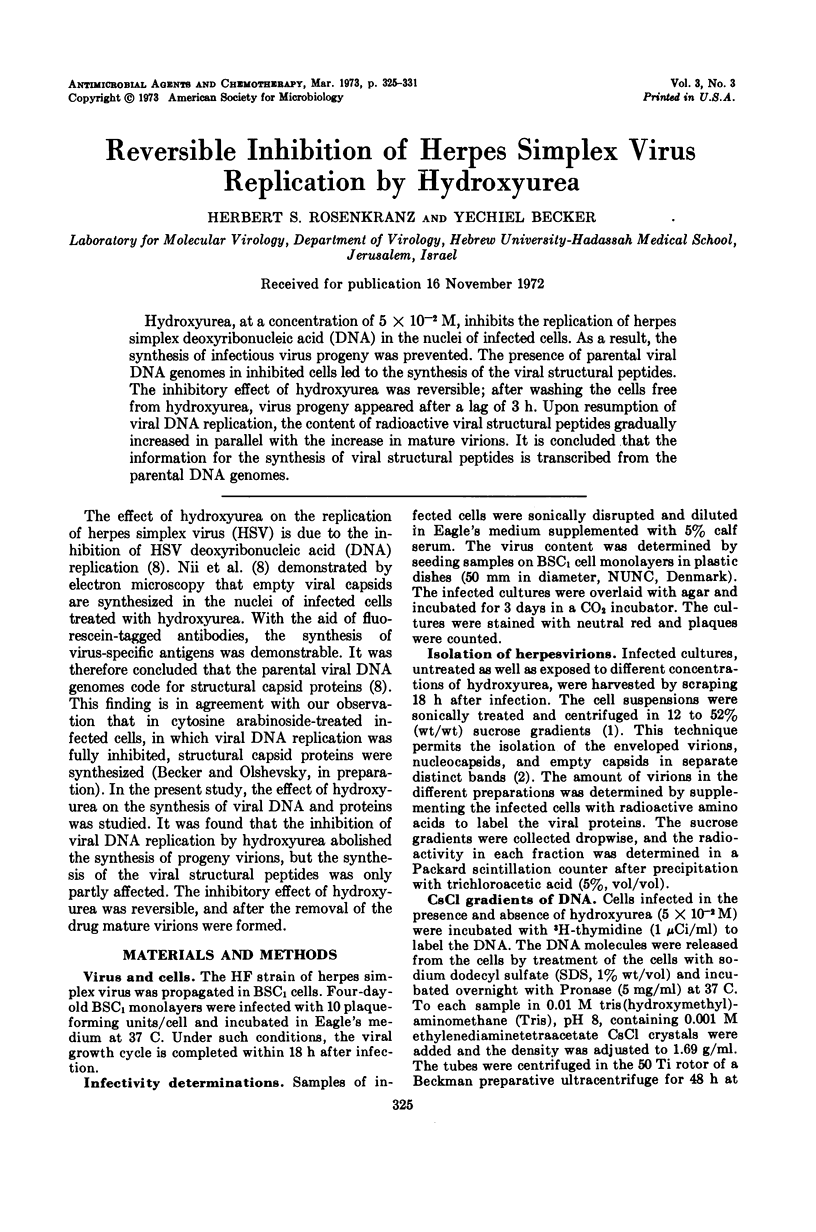

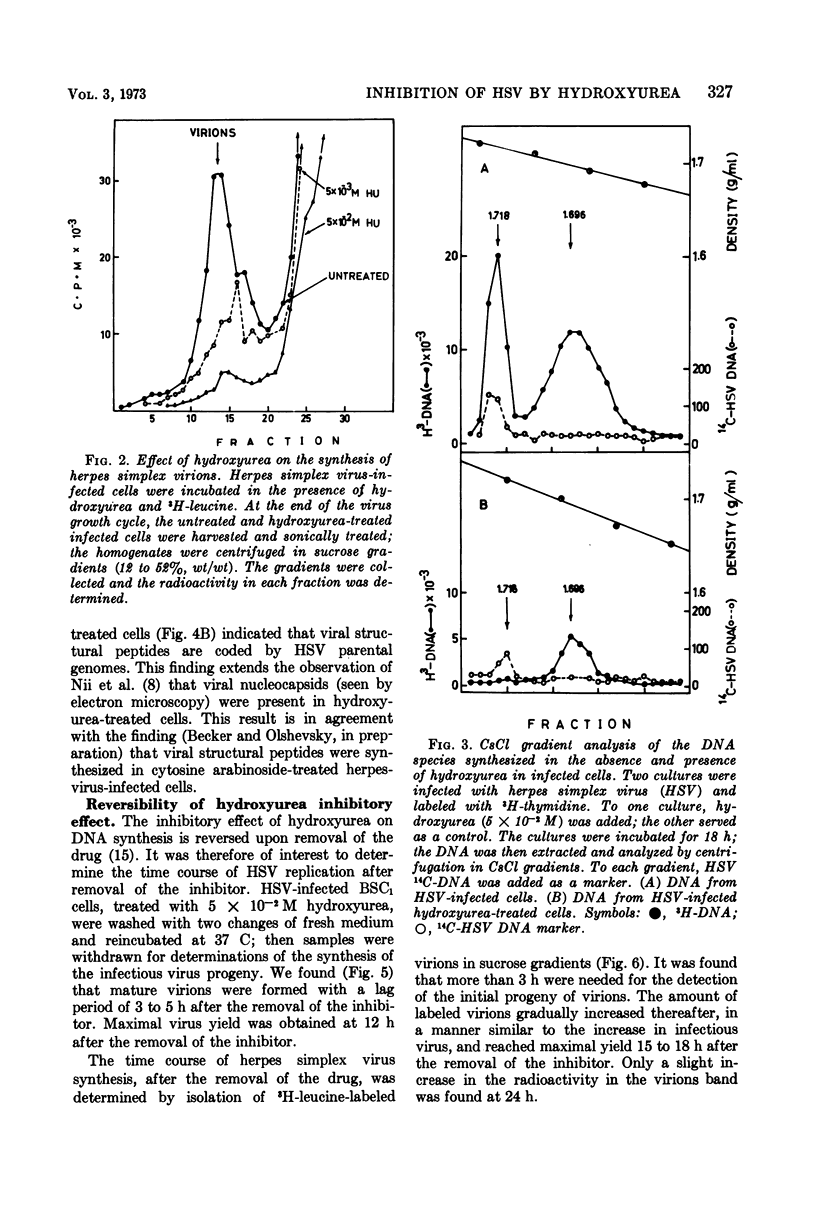
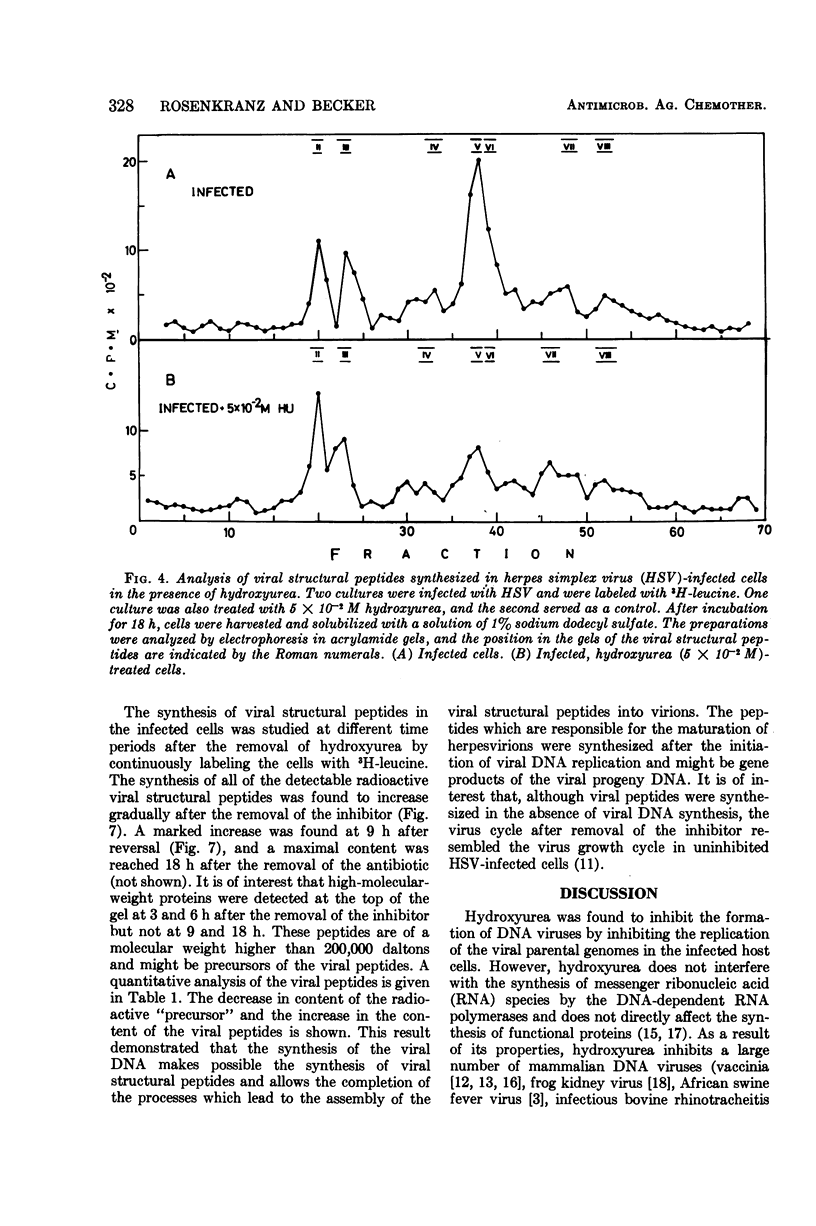
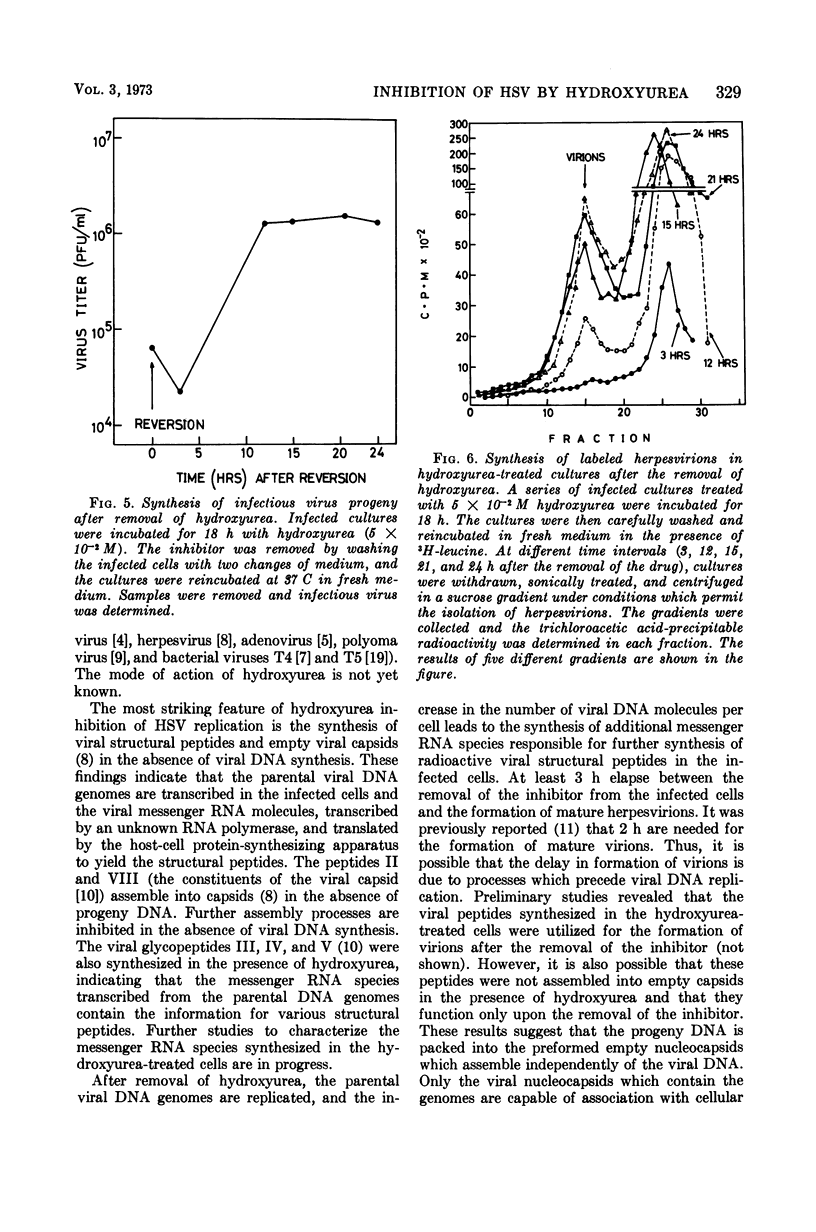
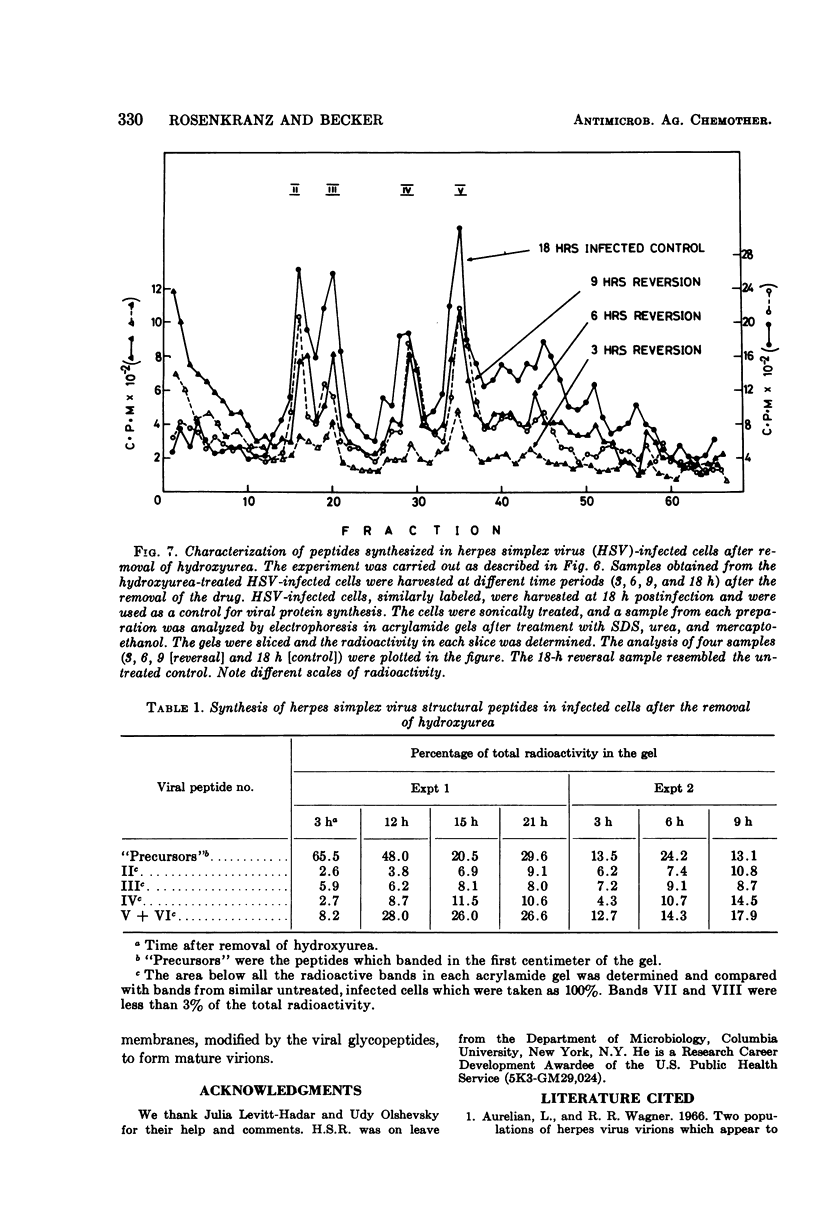
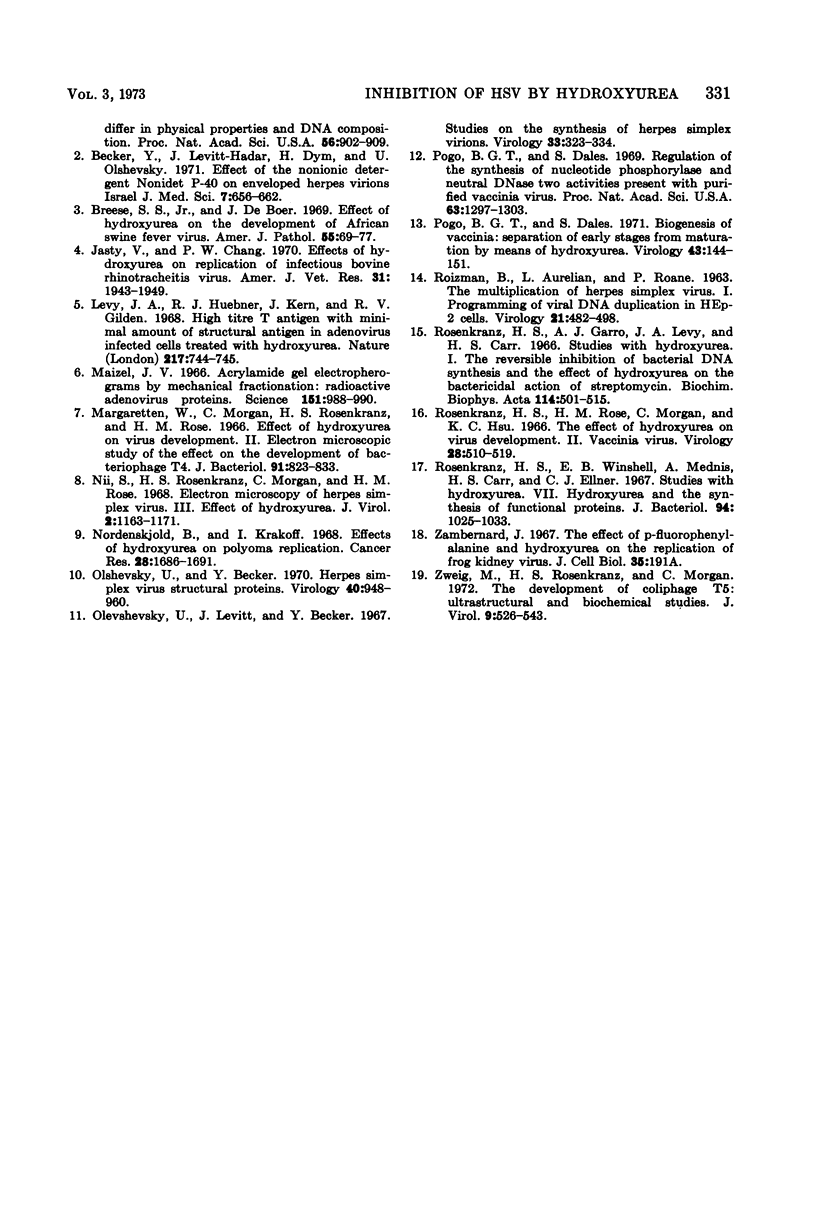
Selected References
These references are in PubMed. This may not be the complete list of references from this article.
- Becker Y., Levitt-Hadar J., Dym H., Olshevsky U. Effect of the nonionogenic detergent, Nonidet P-40, on enveloped herpes simplex virions. Isr J Med Sci. 1971 May;7(5):656–662. [PubMed] [Google Scholar]
- Breese S. S., Jr, DeBoer C. J. Effect of hydroxyurea on the development of African swine fever virus. Am J Pathol. 1969 Apr;55(1):69–77. [PMC free article] [PubMed] [Google Scholar]
- Jasty V., Chang P. W. Effects of hydroxyurea on replication of infectious bovine rhinotracheitis virus. Am J Vet Res. 1970 Nov;31(11):1943–1949. [PubMed] [Google Scholar]
- Levy J. A., Huebner R. J., Kern J., Gilden R. V. High titre T antigen with minimal amounts of structural antigen in adenovirus-infected cells treated with hydroxyurea. Nature. 1968 Feb 24;217(5130):744–745. doi: 10.1038/217744a0. [DOI] [PubMed] [Google Scholar]
- Maizel J. V., Jr Acrylamide-gel electrophorograms by mechanical fractionation: radioactive adenovirus proteins. Science. 1966 Feb 25;151(3713):988–990. doi: 10.1126/science.151.3713.988. [DOI] [PubMed] [Google Scholar]
- Margaretten W., Morgan C., Rosenkranz H. S., Rose H. M. Effect of hydroxyurea on virus development. I. Electron microscopic study of the effect on the development of bacteriophage T4. J Bacteriol. 1966 Feb;91(2):823–833. doi: 10.1128/jb.91.2.823-833.1966. [DOI] [PMC free article] [PubMed] [Google Scholar]
- Nii S., Rosenkranz H. S., Morgan C., Rose H. M. Electron microscopy of herpes simplex virus. 3. Effect of hydroxyurea. J Virol. 1968 Oct;2(10):1163–1171. doi: 10.1128/jvi.2.10.1163-1171.1968. [DOI] [PMC free article] [PubMed] [Google Scholar]
- Nordenskjöld A., Krakoff I. H. Effects of hydroxyurea on polyoma virus replication. Cancer Res. 1968 Sep;28(9):1686–1691. [PubMed] [Google Scholar]
- Olshevsky U., Becker Y. Herpes simplex virus structural proteins. Virology. 1970 Apr;40(4):948–960. doi: 10.1016/0042-6822(70)90141-8. [DOI] [PubMed] [Google Scholar]
- Olshevsky U., Levitt J., Becker Y. Studies on the synthesis of herpes simplex virions. Virology. 1967 Oct;33(2):323–334. doi: 10.1016/0042-6822(67)90151-1. [DOI] [PubMed] [Google Scholar]
- Pogo B. G., Dales S. Biogenesis of vaccinia: separation of early stages from maturation by means of hydroxyurea. Virology. 1971 Jan;43(1):144–151. doi: 10.1016/0042-6822(71)90232-7. [DOI] [PubMed] [Google Scholar]
- Pogo B. G., Dales S. Regulation of the synthesis of nucleotide phosphohydrolase and neutral deoxyribonuclease: two activities present within purified vaccina virus. Proc Natl Acad Sci U S A. 1969 Aug;63(4):1297–1303. doi: 10.1073/pnas.63.4.1297. [DOI] [PMC free article] [PubMed] [Google Scholar]
- ROIZMAN B., AURELIAN L., ROANE P. R., Jr THE MULTIPLICATION OF HERPES SIMPLEX VIRUS. I. THE PROGRAMMING OF VIRAL DNA DUPLICATION IN HEP-2 CELLS. Virology. 1963 Nov;21:482–498. doi: 10.1016/0042-6822(63)90209-5. [DOI] [PubMed] [Google Scholar]
- Rosenkranz H. S., Garro A. J., Levy J. A., Carr H. S. Studies with hydroxyurea. I. The reversible inhibition of bacterial DNA synthesis and the effect of hydroxyurea on the bactericidal action of streptomycin. Biochim Biophys Acta. 1966 Mar 21;114(3):501–515. [PubMed] [Google Scholar]
- Rosenkranz H. S., Rose H. M., Morgan C., Hsu K. C. The effect of hydroxyurea on virus development. II. Vaccinia virus. Virology. 1966 Apr;28(4):510–519. doi: 10.1016/0042-6822(66)90235-2. [DOI] [PubMed] [Google Scholar]
- Rosenkranz H. S., Winshell E. B., Mednis A., Carr H. S., Ellner C. J. Studies with hydroxyurea. VII. Hydroxyurea and the synthesis of functional proteins. J Bacteriol. 1967 Oct;94(4):1025–1033. doi: 10.1128/jb.94.4.1025-1033.1967. [DOI] [PMC free article] [PubMed] [Google Scholar]
- Zweig M., Rosenkranz H. S., Morgan C. Development of coliphage T5: ultrastructural and biochemical studies. J Virol. 1972 Mar;9(3):526–543. doi: 10.1128/jvi.9.3.526-543.1972. [DOI] [PMC free article] [PubMed] [Google Scholar]


